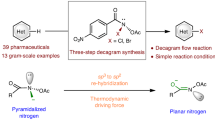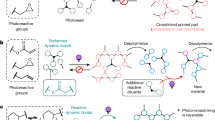Abstract
We report a method to directly introduce a hydroxyl group at the omega chain end of polystyrene prepared by atom-transfer radical polymerization. To achieve the quantitative conversion of the bromine group to a hydroxyl group, the transfer reaction of a carbocation with water was exploited. This transfer reaction is a well-known reaction in cationic polymerization. The quantitative conversion and chemical structures of the hydroxyl-terminated PS were characterized using 1H nuclear magnetic resonance spectroscopy, matrix-assisted laser desorption/ionization time-of-flight mass spectrometry and high-performance liquid chromatography. In addition, alcohol-based compounds were used to introduce acetonide and propane groups into PS-Br.
This is a preview of subscription content, access via your institution
Access options
Subscribe to this journal
Receive 12 print issues and online access
$259.00 per year
only $21.58 per issue
Buy this article
- Purchase on Springer Link
- Instant access to full article PDF
Prices may be subject to local taxes which are calculated during checkout






Similar content being viewed by others
References
Wang J-S, Matyjaszewski K. Controlled/ “living” radical polymerization. atom transfer radical polymerization in the presence of transition-metal complexes. J Am Chem Soc. 1995;117:5614–5.
Kato M, Kamigaito M, Sawamoto M, Higashimura T. Polymerization of methyl methacrylate with the carbon tetrachloride/dichlorotris-(triphenylphosphine) ruthenium (II)/methylaluminum bis (2, 6-di-tert-butylphenoxide) initiating system: possibility of living radical polymerization. Macromolecules. 1995;28:1721–3.
Anastasaki A, Willenbacher J, Fleischmann C, Gutekunst WR, Hawker CJ. End group modification of poly (acrylates) obtained via ATRP: a user guide. Polym Chem. 2017;8:689–97.
Coessens V, Matyjaszewski K. End group transformation of polymers prepared by ATRP, substitution to azides. J Polym Sci A. 1999;36:667–79.
Coessens V, Matyjaszewski K. Synthesis of polymers with hydroxyl end groups by atom transfer radical polymerization. Macromol Rapid Commun. 1999;20:127–34.
Hegewald J, Pionteck J, Häußler L, Komber H, Voit B. End‐functionalized polystyrene by ATRP: a facile approach to primary amino and carboxylic acid terminal groups. J Polym Sci A. 2009;47:3845–59.
Hein JE, Fokin VV. Copper-catalyzed azide–alkyne cycloaddition (CuAAC) and beyond: new reactivity of copper (I) acetylides. Chem Soc Rev 2010;39:1302–15.
Lutz JF, Börner HG, Weichenhan K. Combining atom transfer radical polymerization and click chemistry: a versatile method for the preparation of end‐functional polymers. Macromol Rapid Commun. 2005;26:514–8.
Matyjaszewski K. Atom transfer radical polymerization (ATRP): current status and future perspectives. Macromolecules. 2012;45:4015–39.
Jakubowski W, Kirci‐Denizli B, Gil RR, Matyjaszewski K. Polystyrene with improved chain‐end functionality and higher molecular weight by ARGET ATRP. Macromol Chem Phys. 2008;209:32–39.
Nyström F, Soeriyadi AH, Boyer C, Zetterlund PB, Whittaker MR. End‐group fidelity of copper (0)‐meditated radical polymerization at high monomer conversion: an ESI‐MS investigation. J Polym Sci A. 2011;49:5313–21.
Chong Y, Le TP, Moad G, Rizzardo E, Thang SH. A more versatile route to block copolymers and other polymers of complex architecture by living radical polymerization: the RAFT process. Macromolecules. 1999;32:2071–4.
Gao H, Ohno S, Matyjaszewski K. Low polydispersity star polymers via cross-linking macromonomers by ATRP. J Am Chem Soc. 2006;128:15111–3.
Gaynor SG, Edelman S, Matyjaszewski K. Synthesis of branched and hyperbranched polystyrenes. Macromolecules. 1996;29:1079–81.
Greszta D, Mardare D, Matyjaszewski K. “Living” radical polymerization. 1. Possibilities and limitations Macromolecules. 1994;27:638–44.
Mastan E, Zhu S. A molecular weight distribution polydispersity equation for the ATRP system: quantifying the effect of radical termination. Macromolecules. 2015;48:6440–9.
Yu L, Zhang H, Ding J. A subtle end‐group effect on macroscopic physical gelation of triblock copolymer aqueous solutions. Angew Chem Int Ed. 2006;45:2232–5.
Zhu L-W, Ou Y, Wan L-S, Xu Z-K. Polystyrenes with hydrophilic end groups: synthesis, characterization, and effects on the self-assembly of breath figure arrays. J Phys Chem B. 2014;118:845–54.
Chung J, Yokoyama M, Aoyagi T, Sakurai Y, Okano T. Effect of molecular architecture of hydrophobically modified poly (N-isopropylacrylamide) on the formation of thermoresponsive core-shell micellar drug carriers. J Control Release. 1998;53:119–30.
Yoon S, MacKnight WJ, Hsu SL. End‐group effect on chain conformation of poly (propylene glycol) and poly (ethylene glycol). J Appl Polym Sci. 1997;64:197–202.
Palmiero UC, Sponchioni M, Manfredini N, Maraldi M, Moscatelli D. Strategies to combine ROP with ATRP or RAFT polymerization for the synthesis of biodegradable polymeric nanoparticles for biomedical applications. Polym Chem. 2018;9:4084–99.
Radhakrishnan B, Chambon P, Cloutet E, Cramail H. Synthesis of hydroxy-and dihydroxy-end-capped poly (n-butyl acrylate) s and their use as reactive stabilizers for the preparation of polyurethane latexes. Colloid Polym Sci. 2003;281:516–30.
Liang L, Astruc D. The copper (I)-catalyzed alkyne-azide cycloaddition (CuAAC) “click” reaction and its applications. an overview. Coord Chem Rev. 2011;255:2933–45.
Burgess F, Cunliffe A, MacCallum J, Richards D. Reaction to effect the transformation of anionic polymerization into cationic polymerization: 1. Synthesis and reactivities of anionically generated bromine terminated polymers Polymer. 1977;18:719–25.
Kim K, Hasneen A, Paik H-j, Chang T. MALDI-TOF MS characterization of polystyrene synthesized by ATRP. Polymer. 2013;54:6133–9.
Matyjaszewski K, Davis K, Patten TE, Wei M. Observation and analysis of a slow termination process in the atom transfer radical polymerization of styrene. Tetrahedron. 1997;53:15321–9.
Lin L, Zhang G, Kodama K, Yasutake M, Hirose T. A benign initiating system for cationic polymerization of isobutyl vinyl ether: Silver salt/aryl (alkyl) halide/lewis base. J Polym Sci A. 2015;53:2050–8.
Uchiyama M, Satoh K, Kamigaito M. Diversifying cationic RAFT polymerization with various counteranions: generation of cationic species from organic halides and various metal salts. ACS Macro Lett. 2016;5:1157–61.
Gürdere MB, Budak Y, Ceylan M. Synthesis of 2, 3, 4, 5-tetraphenylfuran,-thiophene and-pyrrole from Toluene. Asian J Chem. 2008;20:1425.
Bartl J, Steenken S, Mayr H. Kinetics of the reactions of laser-flash photolytically generated carbenium ions with alkyl and silyl enol ethers. Comparison with the reactivity toward alkenes, allylsilanes and alcohols. J Am Chem Soc. 1991;113:7710–6.
Kunitake T, Takarabe K. Determination of the rate constants of the elementary steps in the cationic polymerization of styrene by trifluoromethanesulfonic acid. Macromolecules. 1979;12:1061–7.
Bernaerts KV, Schacht EH, Goethals EJ, Prez FEDu. Synthesis of poly (tetrahydrofuran)‐b‐polystyrene block copolymers from dual initiators for cationic ring‐opening polymerization and atom transfer radical polymerization. J Polym Sci A. 2003;41:3206–17.
Shen X, He X, Chen G, Zhou P, Huang L. MALDI‐TOF mass spectrometry characterization of C60 end‐capped polystyrene prepared by ATRP. Macromol Rapid Commun. 2000;21:1162–5.
Francis R, Lepoittevin B, Taton D, Gnanou Y. Toward an easy access to asymmetric stars and miktoarm stars by atom transfer radical polymerization. Macromolecules. 2002;35:9001–8.
Lee W, Cho D, Chun BO, Chang T, Ree M. Characterization of polystyrene and polyisoprene by normal-phase temperature gradient interaction chromatography. J Chromatogr A. 2001;910:51–60.
Chang T, Recent advances in liquid chromatography analysis of synthetic polymers. Adv. Polym. Sci. 2003;163:1–60.
Macko T, Hunkeler D. Liquid chromatography under critical and limiting conditions: a survey of experimental systems for synthetic polymers. Adv Polym Sci. 2003;163:61–136.
Oh J, Kuk J, Lee T, Ye J, Paik H-j, Lee HW, et al. Molecular weight distribution of living chains in polystyrene prepared by atom transfer radical polymerization. ACS Macro Lett. 2017;6:758–61.
Sinnwell S, Ritter H. Microwave accelerated polymerization of 2‐phenyl‐5, 6‐dihydro‐4H‐1, 3‐oxazine: kinetics and influence of end‐groups on glass transition temperature. Macromol Rapid Commun. 2006;27:1335–40.
Acknowledgements
This work was supported by the Basic Science Research Program through the National Research Foundation of Korea (NRF) grant funded by the Korean government (MSIP) (NRF-2018R1A2B6005119).
Author information
Authors and Affiliations
Corresponding authors
Ethics declarations
Conflict of interest
The authors declare that they have no conflict of interest.
Additional information
Publisher’s note: Springer Nature remains neutral with regard to jurisdictional claims in published maps and institutional affiliations.
Supplementary information
Rights and permissions
About this article
Cite this article
Kim, K., Seo, M.G., Jung, J. et al. Direct introduction of hydroxyl groups in polystyrene chain ends prepared by atom-transfer radical polymerization. Polym J 52, 57–64 (2020). https://doi.org/10.1038/s41428-019-0250-z
Received:
Revised:
Accepted:
Published:
Issue Date:
DOI: https://doi.org/10.1038/s41428-019-0250-z



